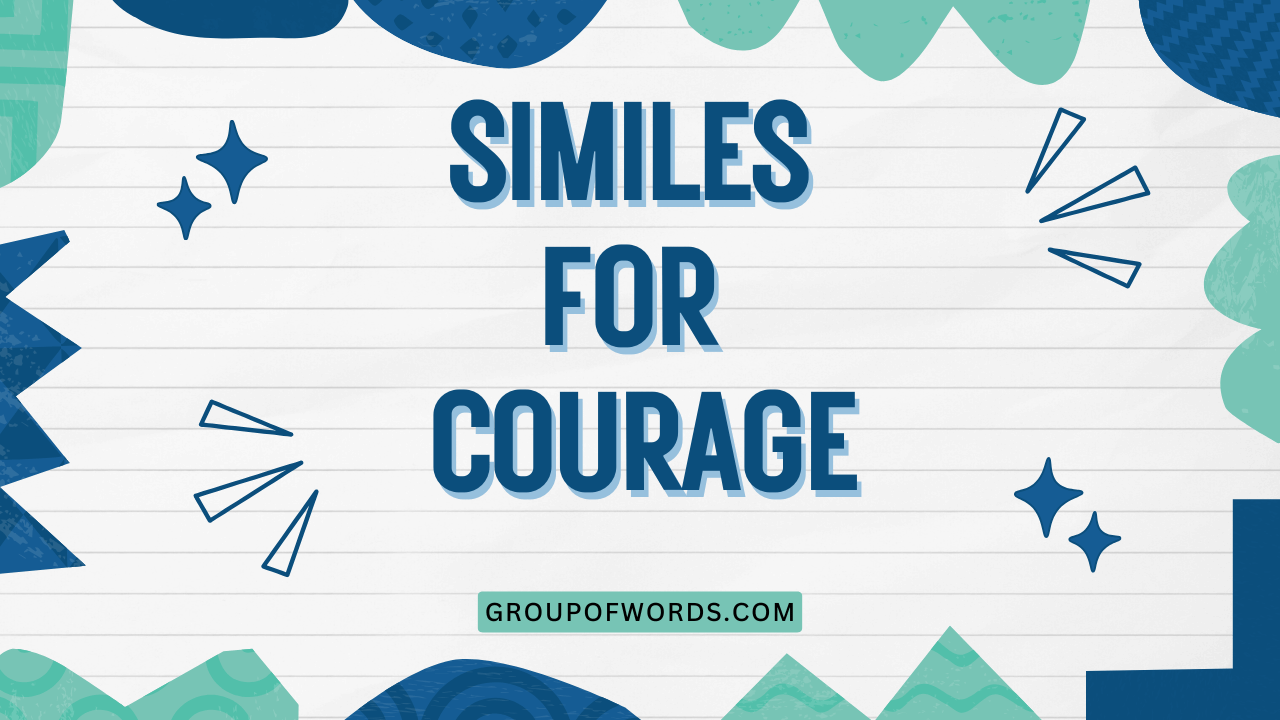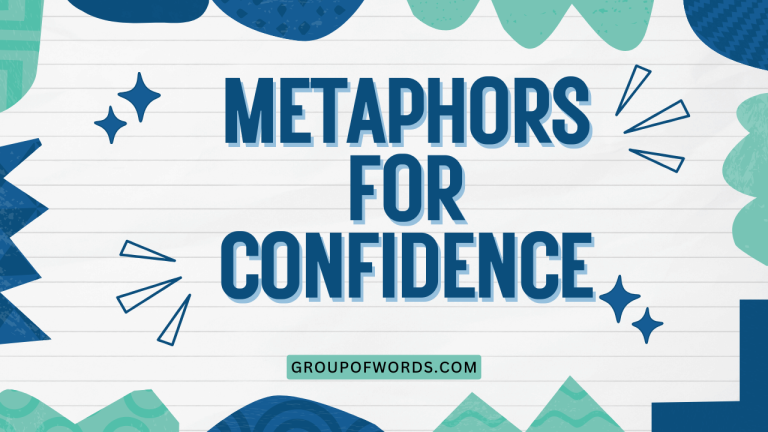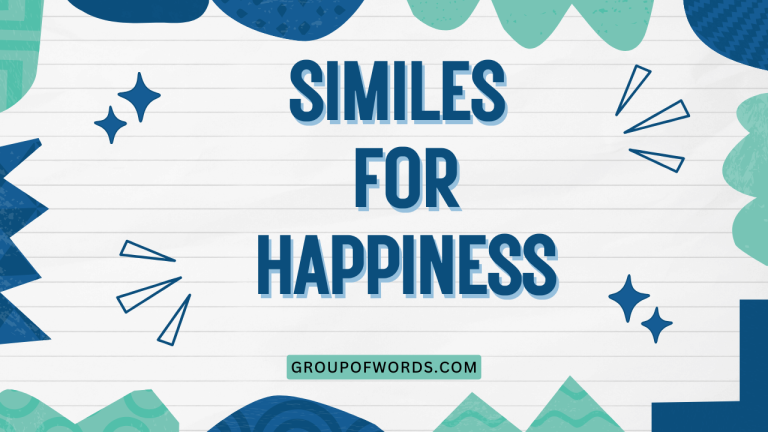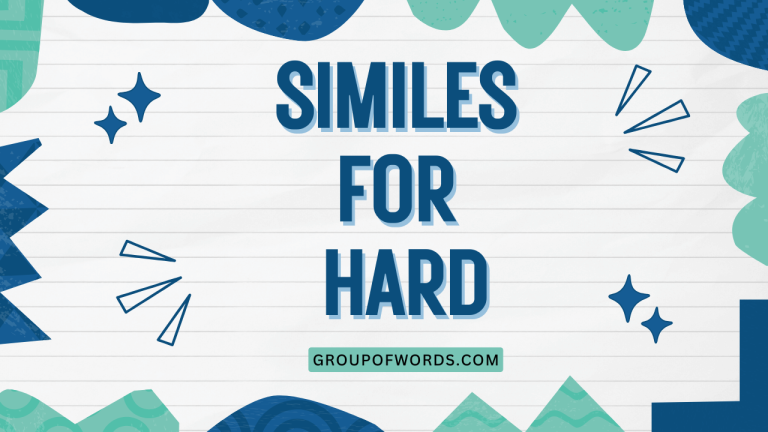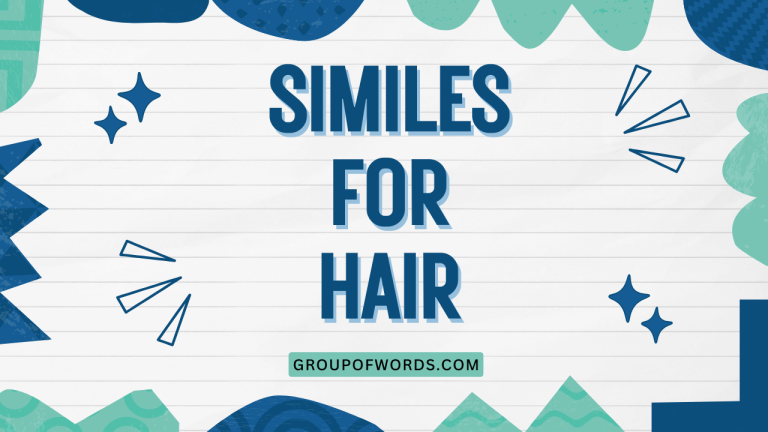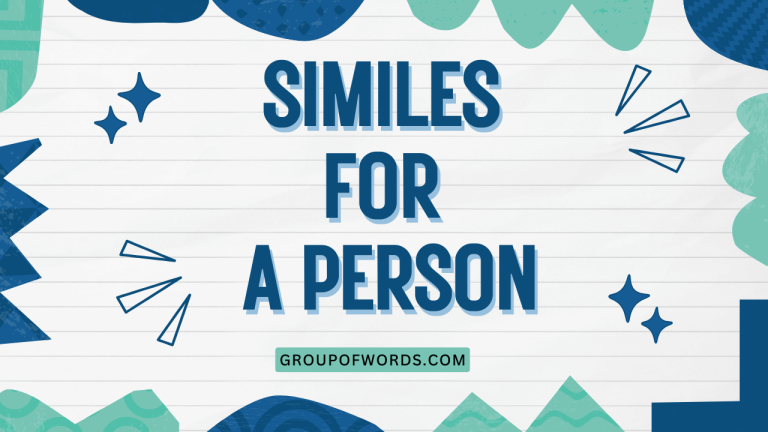Similes for Courage: Mastering Figurative Language
Understanding similes is crucial for enhancing your descriptive writing and adding depth to your communication. Similes, a type of figurative language, allow you to compare two unlike things using “like” or “as,” creating vivid imagery and impactful expressions.
This article focuses specifically on similes used to describe courage, exploring their structure, usage, and the various ways they can enrich your writing. Whether you are a student, writer, or language enthusiast, this comprehensive guide will equip you with the knowledge and skills to effectively use similes to convey courage in your work.
This article is designed for English language learners, writers looking to improve their descriptive skills, and anyone interested in exploring the nuances of figurative language. By understanding the construction and application of similes, you can elevate your writing and create more engaging and memorable content.
This guide provides numerous examples, practice exercises, and insightful explanations to help you master the art of using similes for courage.
Table of Contents
- Introduction
- Definition of Simile
- Structural Breakdown of Similes
- Types of Courage Depicted in Similes
- Examples of Similes for Courage
- Usage Rules for Similes
- Common Mistakes When Using Similes
- Practice Exercises
- Advanced Topics in Similes
- Frequently Asked Questions
- Conclusion
Definition of Simile
A simile is a figure of speech that directly compares two different things using the words “like” or “as.” The primary function of a simile is to enhance description by creating a vivid and relatable image in the reader’s mind. It allows writers to convey complex ideas or emotions in a simple and understandable way, making the text more engaging and impactful.
Similes are an essential tool in both creative writing and everyday communication.
Similes are classified as a type of figurative language, which means they use words or expressions with a meaning that is different from the literal interpretation. This allows for more creative and imaginative expression.
In the context of describing courage, similes can be particularly effective in conveying the strength, bravery, and resilience of a person or character.
Structural Breakdown of Similes
The basic structure of a simile consists of three main components: the subject, the linking word (“like” or “as”), and the comparison. The subject is the thing being described, the linking word establishes the comparison, and the comparison is the thing the subject is being compared to. Understanding this structure is crucial for creating effective and meaningful similes.
For example, in the simile “He was as brave as a lion,” “He” is the subject, “as” is the linking word, and “a lion” is the comparison. This structure allows the reader to understand that the subject possesses the characteristic of bravery, similar to the perceived bravery of a lion.
The structure remains consistent for all similes, regardless of the specific comparison being made.
The linking words “like” and “as” are interchangeable in many cases, but there can be subtle differences in their usage. “As” is often used for comparisons that are more direct or inherent, while “like” can be used for comparisons that are more suggestive or approximate.
However, in most cases, either word can be used without significantly altering the meaning of the simile.
Types of Courage Depicted in Similes
Courage can manifest in various forms, each with its unique characteristics. Similes can be tailored to capture these different facets of courage, providing a nuanced and comprehensive portrayal.
Here are some types of courage commonly depicted in similes:
Physical Courage
Physical courage involves bravery in the face of physical danger or pain. Similes that depict physical courage often use comparisons to animals known for their strength and fearlessness, or to natural phenomena that represent power and resilience.
Moral Courage
Moral courage is the ability to stand up for one’s beliefs, even in the face of opposition or adversity. Similes for moral courage often emphasize steadfastness, integrity, and the willingness to challenge injustice.
Emotional Courage
Emotional courage involves facing one’s fears, vulnerabilities, and difficult emotions with bravery and openness. Similes for emotional courage often highlight resilience, vulnerability, and the ability to persevere through emotional challenges.
Intellectual Courage
Intellectual courage refers to the willingness to question assumptions, challenge conventional wisdom, and pursue truth, even when it is unpopular or uncomfortable. Similes for intellectual courage often emphasize curiosity, open-mindedness, and the pursuit of knowledge.
Examples of Similes for Courage
Here are numerous examples of similes for courage, categorized by the type of courage they depict. Each example is designed to illustrate the use of similes in conveying different aspects of bravery and resilience.
Similes for Physical Courage
The following table provides examples of similes that illustrate physical courage. These similes often compare individuals to animals or natural forces known for their strength and fearlessness, highlighting their ability to face physical danger with bravery.
| Simile | Explanation |
|---|---|
| He was as brave as a lion. | Compares his bravery to the perceived fearlessness of a lion. |
| She fought like a tiger defending her cubs. | Illustrates her fierce courage and protectiveness. |
| He stood his ground like a rock in a storm. | Emphasizes his unwavering courage and resilience. |
| She charged into battle like a raging bull. | Depicts her aggressive and fearless approach to combat. |
| He was as fearless as a soldier on the front lines. | Highlights his bravery in the face of danger. |
| She faced the fire like a salamander. | Compares her resilience to the mythical creature known to withstand flames. |
| He was as tough as nails. | Illustrates his physical resilience and courage. |
| She was like an unyielding fortress. | Emphasizes her strength and invulnerability. |
| He was as bold as a hawk. | Compares his bravery to the hawk’s daring nature. |
| She confronted the danger like a seasoned warrior. | Highlights her experience and bravery in facing threats. |
| He was as resolute as a mountain. | Emphasizes his unwavering resolve and courage. |
| She advanced like a relentless wave. | Depicts her unstoppable courage and determination. |
| He was as sturdy as an oak tree. | Illustrates his strength and resilience. |
| She was like a beacon in the darkness. | Emphasizes her courage as a guiding light. |
| He was as valiant as a knight of old. | Compares his bravery to the legendary courage of knights. |
| She faced the challenge like a true champion. | Highlights her courage and ability to overcome obstacles. |
| He was as unwavering as a compass. | Emphasizes his steadfast direction and courage. |
| She stood her ground like an ancient redwood. | Demonstrates her strength and ability to withstand challenges. |
| He approached the task like a seasoned explorer. | Showcases his bravery and experience. |
| She was as dauntless as a climber scaling Everest. | Compares her bravery to the fearlessness of climbing the highest mountain. |
| He was like a lighthouse in a storm. | Demonstrates his strength and guidance in difficult situations. |
| She faced the challenge like a general leading troops. | Highlights her leadership and bravery. |
| He was as unflinching as a surgeon. | Compares his courage to the steady hand of a surgeon. |
| She was like a shield against adversity. | Emphasizes her protective and courageous nature. |
| He was as tenacious as a bulldog. | Compares his courage to the tenacity of a bulldog. |
| She faced the ordeal like a phoenix rising from ashes. | Highlights her resilience and courage in overcoming challenges. |
Similes for Moral Courage
The following table provides examples of similes that illustrate moral courage. These similes often compare individuals to symbols of justice, integrity, and unwavering principles, highlighting their ability to stand up for what is right, even in the face of opposition.
| Simile | Explanation |
|---|---|
| He stood up for his beliefs like a beacon of truth. | Emphasizes his unwavering commitment to his principles. |
| She defended the innocent like a guardian angel. | Illustrates her protective and righteous courage. |
| He was as steadfast as a judge upholding the law. | Highlights his integrity and commitment to justice. |
| She spoke out against injustice like a clarion call. | Depicts her courageous voice in challenging wrongdoing. |
| He was as unyielding as a monument to justice. | Emphasizes his unwavering commitment to fairness. |
| She held her ground like a moral compass. | Compares her integrity to a guiding force. |
| He faced the opposition like a lone wolf. | Illustrates his courage to stand alone for his beliefs. |
| She was like a voice in the wilderness. | Emphasizes her courage to speak out when others are silent. |
| He was as upright as a pillar of virtue. | Compares his moral character to a symbol of integrity. |
| She championed the cause like a knight errant. | Highlights her dedication to fighting for justice. |
| He was as principled as a founding father. | Emphasizes his commitment to moral and ethical standards. |
| She fought for equality like a civil rights leader. | Depicts her courage in advocating for social justice. |
| He was as resolute as a reformer. | Illustrates his determination to bring about positive change. |
| She stood firm like an advocate for the voiceless. | Emphasizes her courage to speak for those who cannot speak for themselves. |
| He was as courageous as a whistleblower. | Compares his bravery to someone who exposes wrongdoing. |
| She challenged the status quo like a revolutionary. | Highlights her courage to question and change established norms. |
| He was as unwavering as a truth-seeker. | Emphasizes his relentless pursuit of honesty and justice. |
| She was like a conscience for the community. | Highlights her moral guiding presence. |
| He was as bold as a protester marching for change. | Compares his courage to those who advocate for social justice. |
| She stood for her values like a lone tree on a hill. | Demonstrates her strength and resilience in upholding her beliefs. |
| He was as ethical as a saint. | Illustrates his commitment to high moral standards. |
| She spoke truth to power like a prophet of old. | Highlights her courage to challenge authority with honesty. |
| He was as righteous as a judge rendering a fair verdict. | Compares his integrity to the impartiality of a fair judge. |
| She championed the oppressed like a modern-day hero. | Depicts her courage in standing up for the marginalized. |
| He was as just as a fair ruler. | Illustrates his commitment to equitable treatment. |
| She fought for what was right like a guardian of justice. | Highlights her dedication to upholding moral principles. |
Similes for Emotional Courage
The following table provides examples of similes that illustrate emotional courage. These similes often compare individuals to symbols of resilience, vulnerability, and the ability to persevere through emotional challenges, highlighting their bravery in facing their inner fears and vulnerabilities.
| Simile | Explanation |
|---|---|
| He faced his fears like a tightrope walker crossing a chasm. | Emphasizes his bravery in confronting his anxieties. |
| She opened her heart like a flower blooming in spring. | Illustrates her vulnerability and willingness to embrace emotions. |
| He was as resilient as a willow bending in the wind. | Highlights his ability to bounce back from emotional setbacks. |
| She confronted her past like an explorer charting unknown territory. | Depicts her courage in facing her personal history. |
| He was as vulnerable as a newborn bird. | Emphasizes his openness and willingness to be emotionally exposed. |
| She shared her story like a storyteller unveiling a treasure. | Compares her bravery to sharing her experiences. |
| He embraced his imperfections like a potter admiring his creation. | Illustrates his self-acceptance and emotional maturity. |
| She faced her grief like a sailor navigating a storm. | Highlights her courage in dealing with loss and sorrow. |
| He was as brave as a child learning to ride a bike. | Compares his courage to a child facing a new challenge. |
| She confronted her insecurities like an actor stepping onto a stage. | Depicts her bravery in facing her self-doubt. |
| He was as open as a book. | Emphasizes his willingness to share his feelings. |
| She embraced change like a tree shedding its leaves. | Illustrates her adaptability and emotional strength. |
| He was as strong as an anchor. | Demonstrates his emotional stability and resilience. |
| She faced her demons like a warrior confronting her foes. | Highlights her courage in dealing with her inner struggles. |
| He was as determined as a runner finishing a marathon. | Compares his perseverance to an athlete’s endurance. |
| She allowed herself to be vulnerable like a seed sprouting in the earth. | Depicts her openness to growth and emotional development. |
| He was as steady as a heartbeat. | Emphasizes his emotional stability. |
| She forgave like a river flowing around stones. | Illustrates her ability to let go of anger and resentment. |
| He was as compassionate as a caregiver attending to the sick. | Compares his empathy to the kindness of a healer. |
| She nurtured her spirit like a gardener tending to a garden. | Highlights her self-care and emotional well-being. |
| He was as empathetic as a counselor listening to a patient. | Compares his understanding to a therapist’s. |
| She embraced vulnerability like a dancer expressing herself through movement. | Demonstrates her freedom and emotional expression. |
| He was as accepting as a parent loving a child unconditionally. | Illustrates his unconditional love and support. |
| She transformed her pain like an artist creating beauty from suffering. | Highlights her ability to find meaning and growth in adversity. |
| He was as hopeful as a sunrise. | Compares his optimism to the dawn of a new day. |
| She faced the unknown like an astronaut venturing into space. | Depicts her bravery in exploring new possibilities. |
Similes for Intellectual Courage
The following table provides examples of similes that illustrate intellectual courage. These similes often compare individuals to symbols of curiosity, open-mindedness, and the pursuit of knowledge, highlighting their bravery in questioning assumptions and challenging conventional wisdom.
| Simile | Explanation |
|---|---|
| He questioned assumptions like a scientist conducting experiments. | Emphasizes his curiosity and willingness to challenge established ideas. |
| She explored new ideas like a traveler discovering uncharted lands. | Illustrates her open-mindedness and thirst for knowledge. |
| He was as curious as a child exploring the world. | Highlights his eagerness to learn and discover new things. |
| She challenged conventional wisdom like a philosopher questioning existence. | Depicts her courage in questioning established norms. |
| He was as open-minded as a blank canvas waiting to be painted. | Emphasizes his receptiveness to new perspectives and ideas. |
| She pursued truth like a detective solving a mystery. | Compares her determination to uncover knowledge. |
| He was as innovative as an inventor creating new technology. | Illustrates his creativity and willingness to think outside the box. |
| She challenged dogma like a reformer questioning religious doctrine. | Highlights her courage in challenging established beliefs. |
| He was as insightful as a wise sage. | Compares his intellectual depth to a knowledgeable elder. |
| She embraced complexity like a mathematician solving equations. | Depicts her ability to understand and navigate intricate concepts. |
| He was as analytical as a computer processing data. | Emphasizes his ability to break down complex information. |
| She challenged the norm like a rebel fighting for change. | Highlights her willingness to defy convention. |
| He was as perceptive as an artist seeing beauty in the mundane. | Compares his ability to see beyond the surface. |
| She embraced paradox like a physicist exploring quantum mechanics. | Illustrates her ability to reconcile contradictory ideas. |
| He was as inquisitive as a journalist uncovering a story. | Compares his determination to seek the truth. |
| She explored the unknown like a scientist venturing into the cosmos. | Depicts her bravery in exploring uncharted territories of knowledge. |
| He was as discerning as a critic evaluating art. | Emphasizes his ability to make informed judgments. |
| She questioned authority like a lawyer cross-examining a witness. | Highlights her courage to challenge power structures. |
| He was as reflective as a philosopher contemplating existence. | Compares his thoughtfulness to the ponderings of a philosopher. |
| She embraced uncertainty like an entrepreneur launching a startup. | Depicts her willingness to take risks in pursuit of knowledge. |
| He was as thoughtful as a chess player planning a strategy. | Illustrates his ability to think critically and strategically. |
| She challenged tradition like an artist breaking boundaries. | Highlights her courage to defy established norms. |
| He was as inventive as an engineer designing a new bridge. | Compares his creativity to the ingenuity of an engineer. |
| She questioned assumptions like a historian reinterpreting the past. | Depicts her willingness to challenge established narratives. |
| He was as imaginative as a writer creating a new world. | Illustrates his ability to envision new possibilities. |
| She explored complex theories like a physicist unraveling the universe. | Highlights her courage to tackle difficult concepts. |
Usage Rules for Similes
When using similes, it is essential to follow certain rules to ensure clarity and effectiveness. Here are some key usage rules to keep in mind:
- Ensure a Clear Comparison: The comparison should be easily understandable and relevant to the subject being described.
- Use Familiar Comparisons: Choose comparisons that are familiar to your audience to ensure they can easily grasp the intended meaning.
- Avoid Clichés: Steer clear of overused similes that have lost their impact and originality.
- Maintain Consistency: Ensure the simile aligns with the overall tone and style of your writing.
- Be Specific: The more specific the comparison, the more vivid and impactful the simile will be.
It is also important to consider the context in which the simile is being used. A simile that works well in one context may not be appropriate in another.
Therefore, it is essential to carefully consider the audience, purpose, and tone of your writing when choosing and using similes.
Common Mistakes When Using Similes
Even experienced writers can make mistakes when using similes. Here are some common errors to avoid:
Incorrect: He was brave like a coward.
Correct: He was as brave as a lion.
Explanation: The comparison should be logical and consistent with the intended meaning. Comparing bravery to cowardice is contradictory.
Incorrect: She was as courageous as a rock.
Correct: She was as steadfast as a rock.
Explanation: While a rock can be steadfast, it does not inherently convey courage. The comparison should evoke the specific quality being described.
Incorrect: He was brave like very brave.
Correct: He was as brave as a soldier in battle.
Explanation: A simile must compare two different things, not restate the same quality. The comparison should provide additional insight or imagery.
Incorrect: She was courageous as a flower.
Correct: She was as resilient as a flower pushing through concrete.
Explanation: A flower, by itself, does not evoke courage. Adding “pushing through concrete” makes the comparison more relevant and impactful.
Practice Exercises
Test your understanding of similes for courage with the following exercises. Fill in the blanks to complete the similes, or rewrite the sentences using similes to enhance their descriptive power.
Exercise 1: Fill in the Blanks
Complete the following similes by filling in the blanks with appropriate words or phrases.
| Question | Answer |
|---|---|
| He was as brave as a ________. | He was as brave as a lion. |
| She fought like a ________ defending her young. | She fought like a tiger defending her young. |
| He stood his ground like a ________ in a storm. | He stood his ground like a rock in a storm. |
| She faced her fears like a ________ crossing a tightrope. | She faced her fears like a tightrope walker crossing a tightrope. |
| He was as resolute as a ________ upholding the law. | He was as resolute as a judge upholding the law. |
| She spoke out like a ________ in the wilderness. | She spoke out like a voice in the wilderness. |
| He was as unwavering as a ________ to justice. | He was as unwavering as a monument to justice. |
| She embraced change like a ________ shedding its leaves. | She embraced change like a tree shedding its leaves. |
| He was as strong as an ________. | He was as strong as an anchor. |
| She explored new ideas like a ________ discovering new lands. | She explored new ideas like a traveler discovering new lands. |
Exercise 2: Rewrite the Sentences
Rewrite the following sentences using similes to enhance their descriptive power.
| Question | Answer |
|---|---|
| He was very brave. | He was as brave as a soldier in battle. |
| She showed great courage. | She faced her fears like a warrior confronting a dragon. |
| He stood firm in his beliefs. | He stood firm in his beliefs like a mountain against the wind. |
| She spoke honestly, even when it was difficult. | She spoke honestly, even when it was difficult, like a beacon of truth shining in the darkness. |
| He faced his challenges with resilience. | He faced his challenges with resilience, like a phoenix rising from the ashes. |
| She approached the task fearlessly. | She approached the task fearlessly, like an explorer venturing into the unknown. |
| He was determined to succeed. | He was determined to succeed, like a river carving its path through stone. |
| She remained strong despite her pain. | She remained strong despite her pain, like a vine clinging to a wall in a storm. |
| He was unwavering in his commitment. | He was unwavering in his commitment, like a lighthouse guiding ships through the night. |
| She confronted her fears directly. | She confronted her fears directly, like a lion facing its prey. |
Advanced Topics in Similes
For advanced learners, exploring more complex aspects of similes can further enhance their writing skills. Here are some advanced topics to consider:
- Extended Similes: Developing similes over multiple sentences or paragraphs to create a more detailed and impactful comparison.
- Subtle Similes: Using similes that are less direct and more suggestive, requiring the reader to make a deeper connection.
- Combining Similes with Metaphors: Integrating similes and metaphors to create richer and more layered descriptions.
- Cultural Sensitivity: Being mindful of cultural differences and avoiding comparisons that may be offensive or inappropriate.
By delving into these advanced topics, writers can push the boundaries of their creativity and craft similes that are both powerful and nuanced.
Frequently Asked Questions
Here are some frequently asked questions about similes, particularly in the context of describing courage:
- What is the difference between a simile and a metaphor?
A simile compares two things using “like” or “as,” while a metaphor directly equates two things without using these words. For example, “He is as brave as a lion” (simile) vs. “He is a lion” (metaphor).
- How can I avoid using clichés in my similes?
To avoid clichés, try to think of unique and original comparisons that haven’t been overused. Consider specific details and imagery that can make your similes more vivid and memorable.
- Can a simile be too complex?
Yes, a simile can be too complex if it is difficult for the reader to understand or relate to. The comparison should be clear and accessible to your target audience.
- Is it okay to use similes in formal writing?
Similes can be used in formal writing, but they should be used sparingly and with careful consideration of the tone and style of the piece. Overuse of similes can make the writing seem less serious or professional.
- How do I choose the right comparison for a simile?
Choose a comparison that is relevant, meaningful, and easily understandable to your audience. Consider the specific qualities you want to emphasize and select a comparison that effectively conveys those qualities.
- What if I can’t think of a good simile?
If you’re struggling to come up with a simile, try brainstorming different ideas and associations related to the subject you’re describing. You can also look for inspiration in literature, poetry, and other forms of creative writing.
- How important is the word choice in a simile?
Word choice is crucial. The words you choose can significantly impact the effectiveness and clarity of your simile. Select words that are precise, evocative, and appropriate for the tone of your writing.
- Can similes be used in any type of writing?
Yes, similes can be used in various types of writing, including fiction, non-fiction, poetry, and even technical writing. However, it’s important to use them appropriately and sparingly, depending on the context and purpose of the writing.
Conclusion
Mastering the art of using similes for courage can significantly enhance your writing, allowing you to create vivid and impactful descriptions of bravery, resilience, and strength. By understanding the structure, usage rules, and common mistakes associated with similes, you can effectively convey complex emotions and ideas in a simple and understandable way.
Remember to choose comparisons that are clear, relevant, and original, and to avoid clichés that have lost their impact.
As you continue to practice and experiment with similes, you will develop a greater appreciation for the power of figurative language and its ability to enrich your communication. Whether you are writing a novel, a poem, or a simple email, the ability to use similes effectively will make your writing more engaging, memorable, and impactful.
Embrace the challenge, explore new possibilities, and let your creativity soar.
